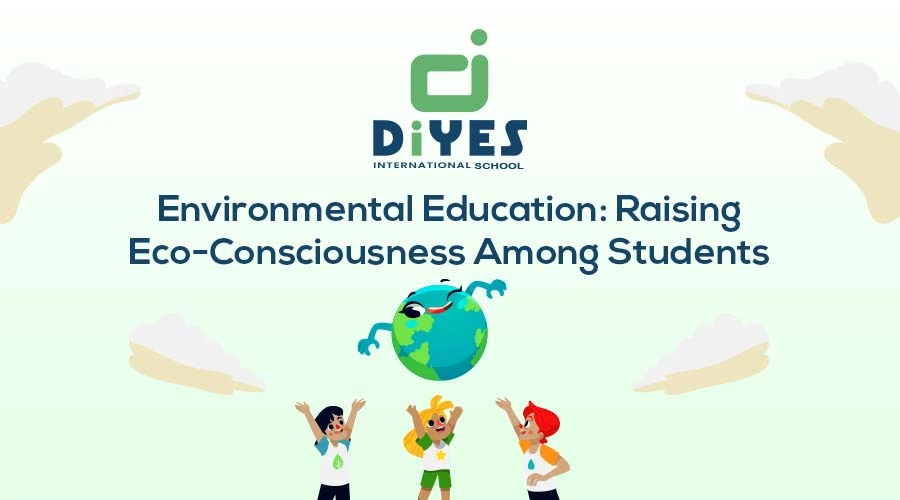In today’s rapidly changing world, there’s a growing need to instill environmental consciousness and responsibility in our young generation. As we face increasingly complex environmental challenges, such as climate change, habitat destruction, and pollution, we find ourselves at a crossroads where education becomes a powerful tool for change. In our ever-changing world, it’s imperative to nurture environmental consciousness among our youth. As we grapple with complex environmental challenges like climate change and pollution, education emerges as a potent force for change.
This blog explores the pivotal role of environmental education in shaping students into eco-conscious stewards of our planet. We delve into the urgency of environmental issues, empower students as change agents, and seamlessly integrate environmental values across disciplines. Hands-on learning experiences, critical thinking, eco-friendly campus initiatives, and community engagement are all essential components of this transformative journey. In conclusion, we emphasize that environmental education is not just a subject—it’s a lifelong commitment to creating a sustainable world, one student at a time.
The Urgency of Environmental Issues
The world we live in today is characterized by a multitude of environmental problems that demand our immediate attention. Climate change, the loss of biodiversity, air and water pollution, deforestation, and habitat destruction are just a few of the pressing issues that affect the health of our planet. These challenges are not confined to textbooks or remote corners of the Earth; they are real, tangible issues that affect us all. Environmental education serves as a crucial means to educate students about these problems, helping them understand the gravity of the situation and inspiring them to become part of the solution.
The Role of Students in Environmental Protection: Empowering Change Agents
Students are pivotal to environmental protection. Educated about environmental issues and involved in hands-on initiatives, they reduce their ecological footprint and become advocates for sustainability in their families and communities.
- Education for Awareness: Environmental education equips students with knowledge about the planet’s challenges, fostering eco-consciousness.
- Advocacy: Empowered students take on leadership roles, advocating for awareness and sustainable practices in schools and communities.
- Promoting Sustainability: Leading by example, students inspire eco-friendly choices and influence others to reduce waste and conserve resources.
- Civic Engagement: They participate in environmental activities, clean-up events, and volunteer work, strengthening their commitment to environmental causes.
- Grassroots Initiatives: Some launch projects like community gardens or climate awareness campaigns to make tangible impacts.
- Online Advocacy: Using social media, students amplify environmental messages, mobilizing online communities for change.
- Future Sustainable Leaders: As future decision-makers, students’ commitment to environmental protection shapes a more sustainable world.
Students are active change agents in the global effort to address environmental challenges and build a sustainable future.
Environmental Awareness Program in Schools
Implementing an environmental awareness program within schools is crucial for nurturing eco-conscious students who understand the importance of environmental stewardship. This comprehensive program should encompass a range of activities and educational initiatives designed to educate students about pressing environmental issues, instill a deep sense of responsibility for the planet, and motivate them to take meaningful action.
In addition to regular workshops, eco-clubs, and eco-friendly projects, this program can involve:

- Integration into the Curriculum: Embedding environmental themes and topics across various subjects, from science and geography to literature and art, ensures that eco-consciousness becomes an integral part of the learning experience.
- Guest Lectures and Experts: Inviting environmental experts and activists to speak at the school, exposing students to diverse perspectives and the latest research in the field, and broadening their understanding of environmental issues.
- Sustainable Infrastructure: Implementing green initiatives within the school, such as energy-efficient lighting, waste reduction measures, and water conservation efforts, sets an example for students and demonstrates the practical aspects of sustainability.
- Community Engagement: Encouraging students to actively participate in community-based environmental projects, collaborating with local environmental organizations, and organizing outreach activities to extend their impact beyond the school’s boundaries.
By incorporating these elements, an environmental awareness program in schools can cultivate a generation of environmentally responsible individuals who are not only aware of the challenges but are also actively engaged in creating a more sustainable future.
Holistic Curriculum Integration
Environmental education is not confined to a single subject; it’s a holistic approach that weaves its principles throughout the entire curriculum. This means integrating environmental concepts into various academic disciplines.
- Science and Environmental Studies: Environmental science courses delve into the intricate web of ecosystems, climate science, and sustainability. Students explore the consequences of human activities on the environment and learn about strategies for mitigating environmental harm.
- Literature and the Environment: Exploring environmental literature exposes students to the beauty of the natural world and the impacts of human actions on it. Works of fiction and non-fiction alike can inspire students to reflect on their relationship with nature.
- Mathematics and Sustainability: Mathematics is instrumental in analysing data related to environmental issues. From calculating carbon footprints to assessing statistical trends in climate data, math plays a vital role in understanding the state of the environment.
- Art and Creative Expression: Art provides a unique platform for students to express their environmental concerns and ideas. Through various forms of artistic expression, they can communicate the urgency of environmental issues and their emotional connection to nature.
- Physical Education and Outdoor Activities: Physical education programs that incorporate outdoor activities, such as hiking, camping, or team sports, introduce students to the joy of being in nature. These experiences not only promote physical well-being but also create lasting memories that connect students to the outdoors.
Hands-On Learning Experiences
Environmental education emphasizes the importance of experiential learning. By engaging students in hands-on experiences, it deepens their understanding of environmental concepts and issues.
- Outdoor Field Trips: Field trips to parks, forests, and wildlife reserves provide students with direct contact with nature. These outings allow them to witness the beauty of the natural world and gain a firsthand understanding of ecosystems.
- Gardening and Sustainable Agriculture: School gardens offer students the opportunity to learn about sustainable agriculture practices, from planting and tending crops to composting. Through these activities, they gain insights into the origins of their food and the importance of responsible land use.
- Conservation Projects: Engaging in conservation projects, such as habitat restoration or tree planting, gives students a tangible sense of accomplishment. They see the immediate impact of their efforts and develop a sense of responsibility for preserving the environment.
- Citizen Science Initiatives: Many environmental education programs involve students in citizen science projects. These initiatives enable students to actively contribute data to scientific research, making them feel like valued participants in the scientific community.
Encouraging Critical Thinking
Critical thinking is at the heart of environmental education.
- Debates and Discussions: Engaging students in debates and discussions about environmental topics encourages them to think critically, analyze different perspectives, and develop well-informed opinions.
- Problem-Solving Activities: Environmental education often includes problem-solving activities that challenge students to find creative solutions to real-world environmental challenges. These activities promote innovation and resourcefulness.
- Guest Speakers and Workshops: Inviting experts and environmental activists to speak at school or conduct workshops exposes students to diverse viewpoints and the latest environmental research. It broadens their horizons and encourages them to explore environmental issues from various angles.
Eco-Friendly Campus Initiatives
Promoting sustainability within the school environment not only sets an example but also provides practical lessons in responsible living.
- Reducing Environmental Footprint: Implementing energy-efficient lighting, waste reduction measures, and water conservation efforts within the school demonstrates sustainable practices in action. It shows students that small changes can lead to significant environmental benefits.
- Promoting Sustainable Practices: Teaching students about recycling, composting, and responsible resource use at school can influence their behaviour at home and in their communities. These practices become ingrained in their daily lives.
- Student-Led Green Projects: Empowering students to take the lead in initiating and managing sustainability projects within the school not only teaches leadership but also allows them to directly impact their school environment.
Nurturing Environmental Values
Environmental education goes beyond knowledge acquisition; it instills values that guide students’ interactions with the environment
- Empathy and Compassion: Environmental education fosters empathy and compassion for all living beings. It instills the understanding that every species plays a vital role in the ecosystem and deserves respect and protection.
- Responsibility and Accountability: Students learn that they are stewards of the Earth, responsible for its well-being. They understand that their actions have consequences for the environment, and they develop a strong sense of personal accountability for their environmental impact.
- Appreciation for Diversity in Nature: Environmental education encourages students to explore the incredible diversity of life on Earth. They learn to appreciate the uniqueness of different ecosystems and species, recognizing the intrinsic value of all living things.
The Future of Environmental Education
As we look ahead, environmental education remains a powerful tool for shaping a sustainable future.
- Preparing Students for Tomorrow: Environmental education equips students with the skills and knowledge they need to address the complex environmental challenges of the future. It prepares them to make informed decisions and engage in meaningful actions to address these challenges.
- Lifelong Learning and Engagement: Environmental education is not a one-time effort but a lifelong journey. It encourages students to continue learning about and advocating for the environment throughout their lives. It fosters a commitment to environmental stewardship that extends far beyond their school years.
- Creating Global Environmental Citizens: Ultimately, the goal of environmental education is to create global citizens who are not only environmentally conscious but also actively engaged in protecting and preserving the planet for future generations. These citizens understand the interconnectedness of global environmental issues and are willing to work collaboratively to address them.
Conclusion
Environmental education is not just about teaching facts; it’s about nurturing values, fostering connections to nature, and empowering students to be agents of positive change. It’s about instilling in them the knowledge and motivation to address the pressing environmental issues of our time. It’s about preparing them to be responsible stewards of the Earth today and in the future.
As we navigate the complex environmental landscape of the 21st century, it is our commitment at DiYES International School to be at the forefront of environmental education. Our mission is to raise eco-conscious students who are not only knowledgeable about the environment but also passionately engaged in its protection. Our programs are designed to instill values of empathy, responsibility, and a deep appreciation for the beauty and diversity of the natural world. Through community engagement and eco-friendly initiatives on our campus, we encourage our students to actively participate in creating a sustainable future.


In the years ahead, we envision our students as leaders, innovators, and advocates for environmental change.
DiYES International School is not just a place of education; it is a launchpad for environmentally conscious global citizens who will continue to make a positive impact long after their time with us. Together, we are building a brighter and greener future, one student at a time.To gain deeper insights into the offerings and ethos of DiYES International School, we encourage you to visit our website, accessible at www.diyesinternational.edu.in. For those who value a more personal connection and wish to engage in direct dialogue, we welcome you to reach out to us directly at +91 8547609000


